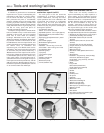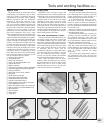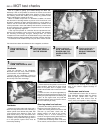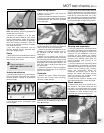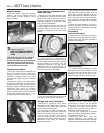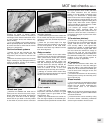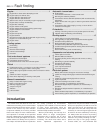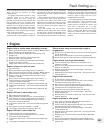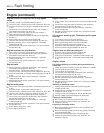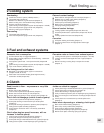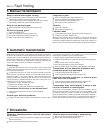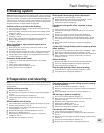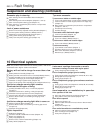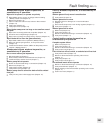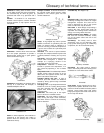
REF•14 Fault finding
Engine (continued)
Engine misfires throughout the driving speed
range
ⅥⅥ Fuel filter choked - fuel-injected models (Chapter 1).
ⅥⅥ Fuel pump faulty, or delivery pressure low (Chapter 4A, 4B or 4C).
ⅥⅥ Fuel tank vent blocked, or fuel pipes restricted (Chapter 4A, 4B
or 4C).
ⅥⅥ Vacuum leak at the carburettor/throttle body, inlet manifold or
associated hoses (Chapter 4A, 4B or 4C).
ⅥⅥ Worn, faulty or incorrectly-gapped spark plugs (Chapter 1).
ⅥⅥ Faulty spark plug HT leads (Chapter 1).
ⅥⅥ Distributor cap cracked or tracking internally (where applicable)
(Chapter 1).
ⅥⅥ Faulty ignition coil or ignition module (Chapter 5B).
ⅥⅥ Uneven or low cylinder compressions (Chapter 2A, 2B or 2C).
ⅥⅥ Blocked carburettor jet(s) or internal passages - carburettor
models (Chapter 4A).
ⅥⅥ Blocked injector/fuel injection system fault - fuel-injected models
(Chapter 4B or 4C).
Engine hesitates on acceleration
ⅥⅥ Worn, faulty or incorrectly-gapped spark plugs (Chapter 1).
ⅥⅥ Vacuum leak at the carburettor/throttle body, inlet manifold or
associated hoses (Chapter 4A, 4B or 4C).
ⅥⅥ Blocked carburettor jet(s) or internal passages - carburettor
models (Chapter 4A).
ⅥⅥ Blocked injector/fuel injection system fault - fuel-injected
(Chapter 4B or 4C).
Engine stalls
ⅥⅥ Vacuum leak at the carburettor/throttle body, inlet manifold or
associated hoses (Chapter 4A, 4B or 4C).
ⅥⅥ Fuel filter choked - fuel-injected models (Chapter 1).
ⅥⅥ Fuel pump faulty, or delivery pressure low (Chapter 4A, 4B or 4C).
ⅥⅥ Fuel tank vent blocked, or fuel pipes restricted (Chapter 4A, 4B, 4C
or 4D).
ⅥⅥ Blocked carburettor jet(s) or internal passages - carburettor
models (Chapter 4A).
ⅥⅥ Blocked injector/fuel injection system fault - fuel-injected models
(Chapter 4B or 4C).
Engine lacks power
ⅥⅥ Timing chain or belt incorrectly fitted or tensioned (Chapter 2A, 2B
or 2C).
ⅥⅥ Fuel filter choked - fuel-injected models (Chapter 1).
ⅥⅥ Fuel pump faulty, or delivery pressure low (Chapter 4A, 4B, or 4C).
ⅥⅥ Uneven or low cylinder compressions (Chapter 2A, 2B or 2C).
ⅥⅥ Worn, faulty or incorrectly-gapped spark plugs (Chapter 1).
ⅥⅥ Vacuum leak at the carburettor/throttle body, inlet manifold or
associated hoses (Chapter 4A, 4B or 4C).
ⅥⅥ Blocked carburettor jet(s) or internal passages - carburettor
models (Chapter 4A).
ⅥⅥ Blocked injector/fuel injection system fault - fuel-injected models
(Chapter 4B or 4C).
ⅥⅥ Brakes binding (Chapters 1 and 9).
ⅥⅥ Clutch slipping (Chapter 6).
Engine backfires
ⅥⅥ Timing chain or belt incorrectly fitted or tensioned (Chapter 2A, 2B
or 2C).
ⅥⅥ Vacuum leak at the carburettor/throttle body, inlet manifold or
associated hoses (Chapter 4A, 4B or 4C).
ⅥⅥ Blocked carburettor jet(s) or internal passages - carburettor
models (Chapter 4A).
ⅥⅥ Blocked injector/fuel injection system fault - fuel-injected models
(Chapter 4B or 4C).
Oil pressure warning light illuminated with engine
running
ⅥⅥ Low oil level, or incorrect oil grade (Chapter 1).
ⅥⅥ Faulty oil pressure warning light switch (Chapter 5A).
ⅥⅥ Worn engine bearings and/or oil pump (Chapter 2D).
ⅥⅥ High engine operating temperature (Chapter 3).
ⅥⅥ Oil pressure relief valve defective (Chapter 2A, 2B or 2C).
ⅥⅥ Oil pick-up strainer clogged (Chapter 2A, 2B or 2C).
Engine runs-on after switching off
ⅥⅥ Excessive carbon build-up in engine (Chapter 2D).
ⅥⅥ High engine operating temperature (Chapter 3).
ⅥⅥ Faulty fuel cut-off solenoid - carburettor models (Chapter 4A).
ⅥⅥ Fuel injection system fault - fuel-injected models (Chapter 4B
or 4C).
Engine noises
Pre-ignition (pinking) or knocking during acceleration or
under load
ⅥⅥ Ignition timing incorrect/ignition system fault (Chapters 1 and 5B).
ⅥⅥ Incorrect grade of spark plug (Chapter 1).
ⅥⅥ Incorrect grade of fuel (Chapter 1).
ⅥⅥ Vacuum leak at the carburettor/throttle body, inlet manifold or
associated hoses (Chapter 4A, 4B or 4C).
ⅥⅥ Excessive carbon build-up in engine (Chapter 2D).
ⅥⅥ Blocked carburettor jet(s) or internal passages - carburettor
models (Chapter 4A).
ⅥⅥ Blocked injector/fuel injection system fault - fuel-injected models
(Chapter 4B or 4C).
Whistling or wheezing noises
ⅥⅥ Leaking inlet manifold or carburettor/throttle body gasket
(Chapter 4A, 4B or 4C).
ⅥⅥ Leaking exhaust manifold gasket or pipe-to-manifold joint
(Chapter 4A, 4B, 4C or 4D).
ⅥⅥ Leaking vacuum hose (Chapters 4A, 4B, 4C, 4D, 5B and 9).
ⅥⅥ Blowing cylinder head gasket (Chapter 2A, 2B and 2C).
Tapping or rattling noises
ⅥⅥ Worn valve gear or camshaft (Chapter 2A, 2B or 2C).
ⅥⅥ Ancillary component fault (coolant pump, alternator, etc)
(Chapters 3, 5A, etc).
Knocking or thumping noises
ⅥⅥ Worn big-end bearings (regular heavy knocking, perhaps less
under load) (Chapter 2D).
ⅥⅥ Worn main bearings (rumbling and knocking, perhaps worsening
under load) (Chapter 2D).
ⅥⅥ Piston slap (most noticeable when cold) (Chapter 2D).
ⅥⅥ Ancillary component fault (coolant pump, alternator, etc)
(Chapters 3, 5A, etc).



